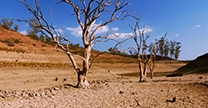Looking for a great project-based lesson? Teachers TryScience features hands-on lessons focused on environmental science. Each lesson is integrated with effective teaching strategies, practical how-to's and other helpful supports.
CREATE A LESSON PLAN
Share your lesson with the Teachers TryScience community! Your lesson will help grow the instructional content on the site.
Click below to get started!
EQuIP Reviewed Lessons
In the United States, the Next Generation Science Standards (NGSS) lay out disciplinary core ideas, science and engineering practices, and crosscutting concepts that students should master in preparation for college and careers. Through a project with Achieve, Inc. and the New York Hall of Science, Teachers TryScience is providing a growing set of lessons that reflect some of the shifts in the NGSS, along with resources that will support you in aligning your own lessons to NGSS.
Units
THINK: The Process of Innovation
Using the THINK app (free for iPad and 10" Android tablets), students will explore how progress is shaped through a common and systematic approach that follows a five-step process of Seeing, Mapping, Understanding, Believing and Acting (SMUBA). Your students will explore the process of innovation and participate in as many as three units, featuring hands-on lessons that will to help them become innovators in their own right and to take actions that can help them become forward-thinking citizens of the world.
Lessons
Languages
560 Lesson Plans
Partner Contributed
Apr 20 2011
Source: TeachEngineerin...
Your Rating:
In this design-based lesson, students study flood dynamics as they modify a riverbed with blockages...
Partner Contributed
EQuIP-reviewed
Jun 29 2015
Source: NYSCI
Your Rating:
Student will answer the driving question:
How can the impact of future flooding events be...
Partner Contributed
Oct 24 2017
Source: Australian Museum
Your Rating:
This lesson is the second in a series of lessons about Australian frogs. This lesson asks students...
Partner Contributed
Mar 20 2011
Source: TeachEngineerin...
Your Rating:
Students investigate the life cycle of an engineered product and then suggest ways to reduce the...
Partner Contributed
Jun 08 2011
Source: biomimicryinstitute
Your Rating:
Students design a shelter, including physical structure, heating and/or cooling mechanisms, an...
Partner Contributed
EQuIP-reviewed
Jul 31 2015
Source: NYSCI
Your Rating:
In this lesson, students will use a particulate air pollution model to observe phenomena. They will...
Partner Contributed
Mar 20 2011
Source: TeachEngineerin...
Your Rating:
In this inquiry-based lesson, students build particulate matter collectors to discover which local...
Partner Contributed
Apr 11 2013
Source: NYSCI
Your Rating:
In this lesson, students will use the "Seeing" portion of the THINK app to understand the...
Partner Contributed
May 29 2013
Source: NYSCI
Your Rating:
In this lesson, students will learn about systems, compare and contrast the interactions within...
Partner Contributed
Nov 19 2012
Source: NYSCI
Your Rating:
In this lesson, students will be introduced to the science of epidemiology, encouraged to think...
Partner Contributed
Apr 11 2013
Source: NYSCI
Your Rating:
In this lesson, students will use the Understanding part of the THINK app to examine systems to...
Partner Contributed
May 29 2013
Source: NYSCI
Your Rating:
In this lesson, students will understand the importance of analyzing the local food system,...
Partner Contributed
Nov 19 2012
Source: NYSCI
Your Rating:
In this lesson, students will recognize that the term “map” does not just correspond to...
Partner Contributed
Apr 11 2013
Source: NYSCI
Your Rating:
In this lesson, students will be creating actual useful climate change vulnerability assessment...
Partner Contributed
May 29 2013
Source: NYSCI
Your Rating:
In this lesson, students will think critically about how to display and present data clearly and...









